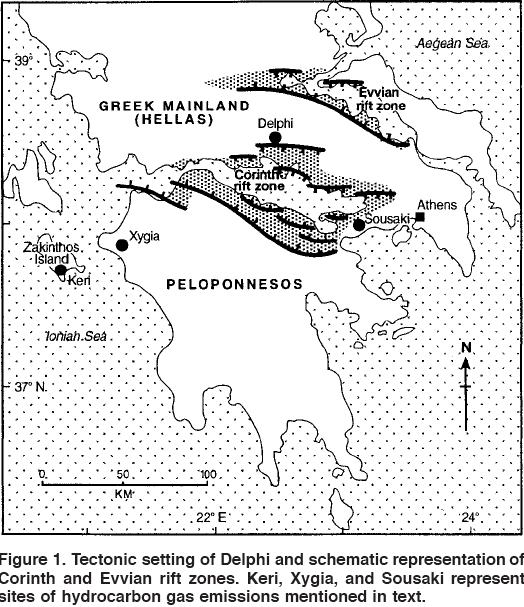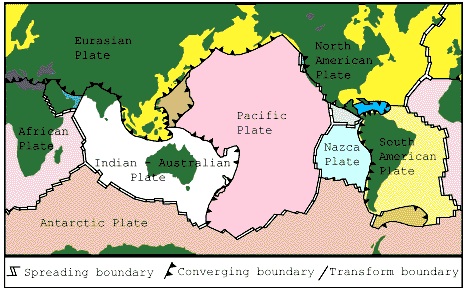In the articles you just read, the authors assume you know something about faults: how they are classified, what kind of motion they experience, what sense of stress they feel, and how to recognize them on a map. Therefore, it is time to step back a little and review some basic material about faults and earthquakes.
A fault is formed in the Earth's crust as a brittle response to stress. Generally, the movement of the tectonic plates provides the stress, and rocks at the surface break in response to this. Faults have no particular length scale. If you whack a hand-sample-sized piece of rock with a hammer, the cracks and breakages you make are faults. At the other end of the spectrum, some plate-boundary faults are thousands of kilometers in length.
Fault categories
The sense of stress determines the type of fault that forms, and we usually categorize that sense of stress in three different ways:
- compression,
- tension, and
- shear.
Handily, these three senses of stress also correlate with the three types of plate boundaries.
- Compressive stress happens at convergent plate boundaries where two plates move toward each other.
- Tensional stress happens at divergent plate boundaries where two plates are moving away from each other.
- Shear stress is experienced at transform boundaries where two plates are sliding past each other.
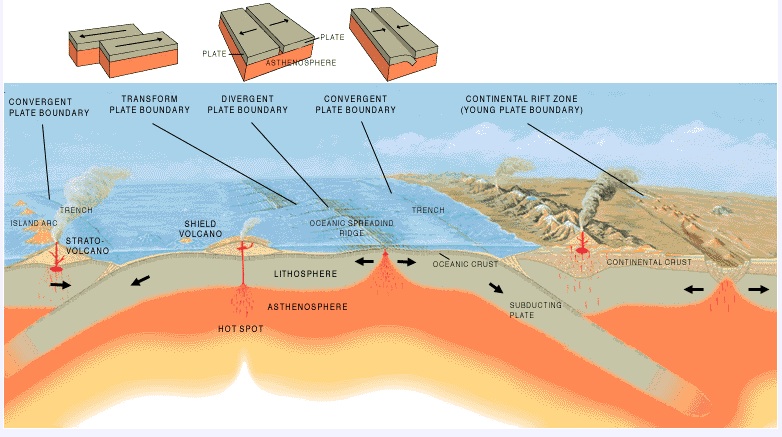
In terms of faulting, compressive stress produces reverse faults, tensional stress produces normal faults, and shear stress produces transform faults. *Terminology alert: Geoscientists refer to faults that are formed by shearing as transform faults in the ocean, and as strike-slip faults on continents. Otherwise, these two types of faults are basically the same thing. Check out the sketches below to see a cartoon of what each of these fault types look like in cross-section.
Eliza's nifty sketches
Here we have a basic cross-section consisting of three rock layers: brown, pink, and granite. You can tell it's a cross-section because I drew a little tree (Bob Ross-style!) and a couple of birds and the sun.
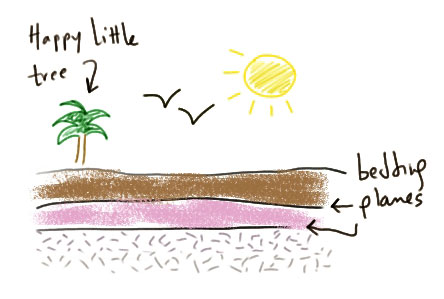
Now we'll apply some tensional stress to this terrain. Tension has the effect of pulling and elongating. If this material were ductile, it would stretch and get thinner, but we are dealing with brittle rocks here, so instead they will break. The way this typically happens is by forming a fault at some angle to the bedding. Then the whole package of rocks slides along this fault. The type of fault formed here is called a normal fault. This terminology came from miners in Germany who noticed that most of the faults where they were working were of this nature, so they called them "normal," meaning typical.
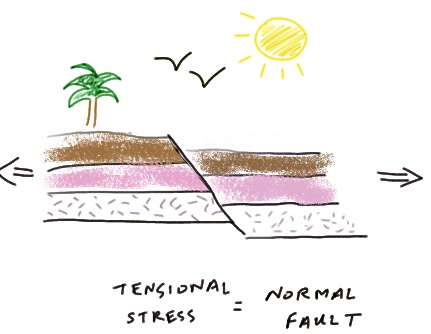
As you can see, the fault has had the effect of dropping the block on the right with respect to the block on the left. If you saw something like this in the field, you'd be able to tell how much offset there was on the fault by measuring how much the layers had moved across the fault.
If we instead apply compressive stress, this has the effect of squeezing and shortening the terrain. A fault will form that looks an awful lot like the normal fault in the previous example, but the motion on this fault is in the opposite direction. This fault is called a reverse fault because it is the "reverse," meaning opposite, of normal. Reverse faults tend to form scarps--a scarp is the piece of rock that has been thrust up higher than the original surface level.
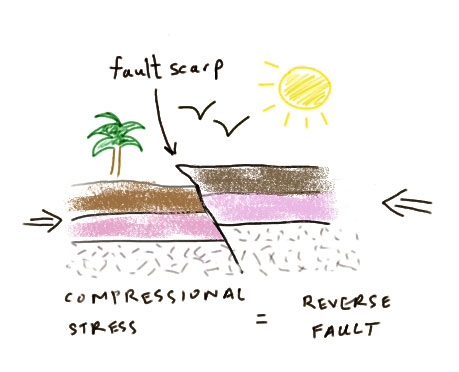
The third typical fault type is the strike-slip fault. Strike-slip faults are distinct from the previous two because they don't involve vertical motion. They form via shear stress. These are not as easy to recognize in cross-section unless there has been so much movement on the fault that there are completely different rock types on either side of the fault. Most strike-slip faults are close to vertical with respect to the bedding.
See in the animation below how the various fault types move. Animation is silent and comes from IRIS.
Each of these three types of faults is marked in a standard way on a geologic map. I've sketched those symbols below.
- A normal fault is typically shown by a line representing the fault trace with a little perpendicular line to show the direction of the block that has slid down. Sometimes two parallel lines are drawn to represent plates moving apart instead.
- A reverse fault is a line with teeth on it. The teeth are drawn on the side of the overriding block. At a subduction zone plate boundary, the teeth are on the upper plate.
- A strike-slip fault is drawn as a line, usually (but not always) with a half-arrow on each side to show which direction the two sides of the fault are moving. The example below shows a left-lateral fault.
.jpg)
Fault symbol ID check!
Can you identify the type of faulting occurring at each plate boundary in the map below? Check your answer here. (and a captioned version).
Applying what you know

Have another look at Figure 1 from de Boer et al., 2001 (reproduced below). What type of faulting is being depicted on that map? Can you picture in three dimensions how the lithosphere is moving in that map? Think about it and compare your idea to my sketch (and a captioned version).
